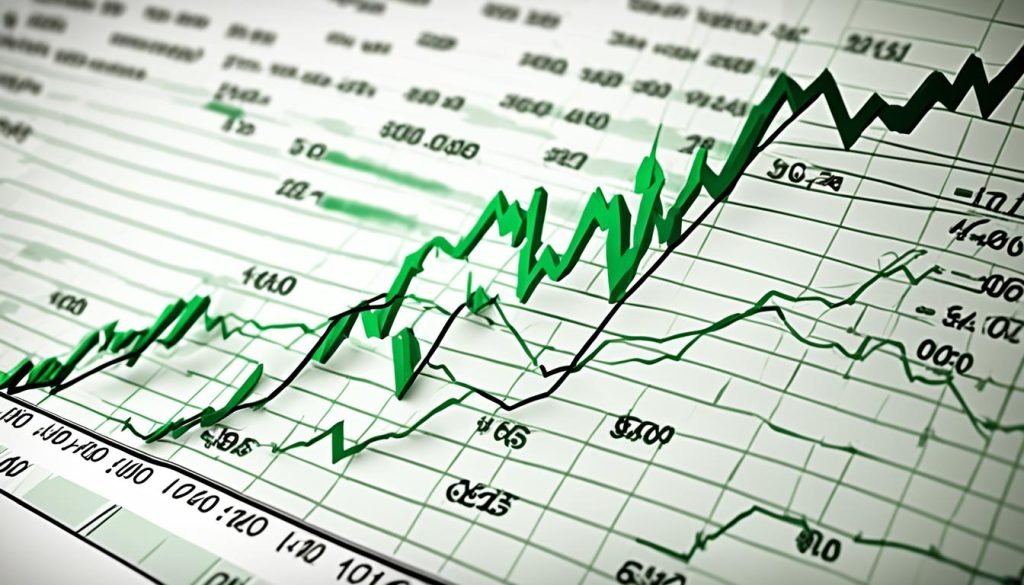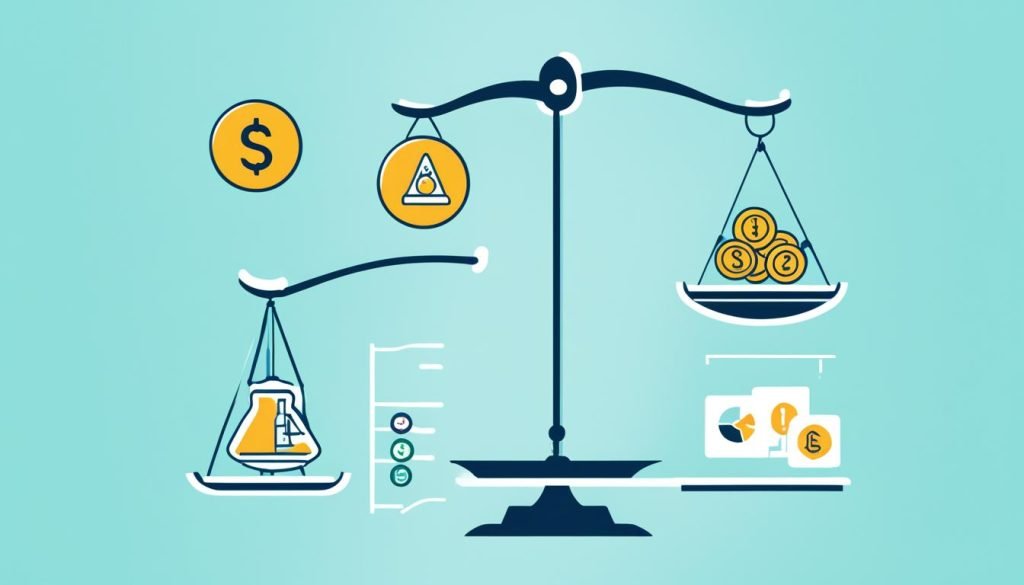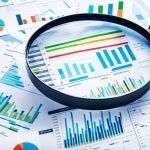Welcome to the latest on economic indicators! In today’s quick financial world, it’s important to keep up with new data and trends. This helps you make smart choices about your investments. By looking at certain indicators, you can understand the economy’s health and where it’s going. Let’s talk about why these indicators are so important.
Key Takeaways:
- It’s crucial to watch economic indicators to see where you should invest and check the economy’s pulse.
- Different types of indicators give us insights into what’s happening now and what might happen next.
- Important indicators to watch are the Consumer Price Index (CPI), gross domestic product (GDP), and unemployment rates.
- To understand these indicators, you need to look at past data, know what the averages are, and use several indicators together.
- Even though the stock market is an indicator, it’s not the whole picture. There are some things to watch out for, like fake trends and bubbles.
Types of Economic Indicators
Economic indicators fall into three big groups: leading, coincident, and lagging. Each type tells us something different about the economy. They help experts make smart choices.
Leading Indicators
Leading indicators hint at what the economy might do next. They’re early signals everyone keeps an eye on. Examples are:
- The yield curve, measuring short and long-term interest rate differences. An inverted curve often means a recession might be coming.
- Consumer durables like cars and new homes. When people buy more, it shows the economy is doing well.
By watching these, investors can prepare for coming changes and trade carefully.
Coincident Indicators
Coincident indicators show us how the economy is doing right now. They’re like a live report. Some examples are:
- Gross Domestic Product (GDP), which tells us the value of a country’s goods and services. It’s a key sign of growth.
- How many people have jobs or are looking for work, known as the unemployment rate. This tells us about spending power and work health.
With these, we see the economy at a glance and spot any big shifts.
Lagging Indicators
Lagging indicators confirm what’s already happened in the economy. They’re useful for knowing if changes are real. Some examples are:
- The Consumer Price Index (CPI) tracks how much we pay for things. It warns of inflation.
- Unemployment rates. High numbers can mean the economy is struggling.
They’re key in doubling-checking the economy’s health and spot its real trends.
“Leading, coincident, and lagging indicators give a full look at the economy’s health.”
Understanding all types of economic indicators is crucial for wise investing. Knowing what leading, coincident, and lagging indicators show can help us see risks and seize chances.
Interpreting Economic Indicators
It’s key to understand economic indicators for smart financial moves and to grasp the economy’s status. Gross domestic product (GDP) is a big one for spotting economic growth. Its rise often reflects on companies doing well. But, knowing just GDP isn’t enough. Company gains might also hinge on things like what people feel, the market, or their field’s unique issues.
It’s smart to check these indicators over time. Spotting long-term trends can show us what’s normal or odd lately. Comparing today’s stats with what the past shows helps assess if we’re doing as well as we should.
“Interpreting economic indicators is like looking through a window into the economy’s health. It requires a holistic approach and the consideration of multiple indicators to gain a comprehensive understanding.”
– Michael Johnson, Chief Economist at Global Insights
Looking at many indicators gives a fuller view on the economy. This means checking job numbers, how prices change, what people buy, and more. With this mix, experts can draw clearer pictures and predict economic changes better.
Comparing Economic Indicators: A Case Study
Let’s look at GDP growth and unemployment rates over five years. See how they changed:
| Year | GDP Growth | Unemployment Rate |
|---|---|---|
| 2017 | 3.2% | 4.1% |
| 2018 | 2.9% | 3.9% |
| 2019 | 2.4% | 3.7% |
| 2020 | -3.5% | 8.1% |
| 2021 | 5.1% | 4.2% |
The chart shows how GDP growth and unemployment are linked. In 2020, the economy plunged, leading to job losses. But in 2021, things turned around. The economy grew, and many got jobs back. This shows why we need many signs to judge how our economy is doing.
Truly understanding economic indicators goes deeper than a single figure. By looking at many trends and comparing stats, the big picture emerges. This lets investors and leaders make the right moves and change with the market.
Stock Market as an Indicator
The stock market is key for showing where the economy might be heading. It does this by how stocks and indices behave. This way, investors and analysts know what the mood is and can act smartly with their money.
We should be aware of the stock market’s limits. Anyone could try to mess with prices for their gain, which can lead us to the wrong conclusions. It’s a good reminder to always be careful when looking at stock movements.
Stock market bubbles are a real thing too. They happen when prices get crazy high, but it’s not for real reasons. This happens when investors keep pushing prices up, thinking they are worth more than they are. But this doesn’t last and can end in a crash. So it’s very important to know how to spot these bubbles and avoid losing money.
Stock market prices are based on earnings estimates and investor expectations. But these numbers can be off, and people’s feelings about the market can change suddenly. So, it’s best to check the stock market story against other economic details.
We can understand the market better by checking different indicators like GDP, job rates, inflation, and what people are spending. This broad look helps investors keep their losses low. They don’t rely just on the stock prices to make decisions.
Stock Market Example
Imagine the stock market is doing really well. Stock prices are going up a lot, making it look like the economy is doing great. This attracts investors who want to join in on the success.
But, looking at other economic info, like slow GDP growth, high jobless rates, and increasing prices for goods, tells a different story. This shows the economy isn’t as strong as the stock prices suggest.
Benefits of Using Multiple Economic Indicators
Taking a wide look at the economy is better than just focusing on the stock market. It gives a truer picture of what’s going on, without getting fooled by temporary market jumps.
Understanding different economic signs gives investors a better grip on the market. They can make wiser choices and manage their investments more effectively.

| Advantages | Disadvantages |
|---|---|
|
|
Table: Advantages and Disadvantages of Using the Stock Market as an Economic Indicator
Advantages and Disadvantages of Economic Indicators
Economic indicators are key to understanding an economy’s health. They offer insights into what’s happening now and what might happen. This knowledge helps people in business and government make smart choices. But, these tools have their pluses and minuses. Let’s dive into them.
Advantages of Economic Indicators
One big plus is that these indicators use real data for their forecasts. This makes them trustworthy because they’re not guesses; they’re facts. They let us look back and predict the economy’s future with some accuracy.
Another good thing is that anyone can find and use economic indicators. This means people from all walks of life can get the info they need. Whether you’re checking out the GDP or tracking job numbers, these tools are for everyone.
Economic indicators are like a compass, guiding investors through the ups and downs of the market. By monitoring these indicators, we can identify potential investment opportunities and adjust our strategies accordingly.
Disadvantages of Economic Indicators
However, there are snags to using them. A big one is that they’re based on some guesses. Even though they use data, they also make assumptions about the economy’s moving parts. If those assumptions are off, the predictions can be too.
These tools also struggle to catch everything that influences an economy. Things like new tech, changing cultures, or big global events can rock the economy. But, these may not show up in traditional indicators. To really understand, you need to look beyond the numbers.
“Economic indicators should be seen as one piece of the puzzle rather than the sole measure of a country’s economic health. It’s crucial to consider other factors that can influence an economy and its trajectory,” says Jane Richards, Chief Economist at Global Research Group.
Pros and Cons of Economic Indicators
| Advantages | Disadvantages |
|---|---|
| Reliable and objective data | Rely on assumptions |
| Freely available and publicly accessible | May not capture complex realities |
| Help make informed decisions | Can be influenced by external events |
These indicators are good for solid facts and guiding decisions. But, they’re not perfect. They do have limits, like making guesses and missing some info. Like any tool, you need to pair them with other knowledge and take the big picture into account.

The Most Important Economic Indicator
Gross Domestic Product (GDP) is seen as the top economic indicator. It gives us a quick view of how well a country is doing economically. This is by showing the total value of what the country makes and sells. GDP helps us see if an economy is growing or not.
GDP includes final goods, services, investments, government spending, and exports. So, it shows how well an economy is doing overall. It’s an important way to measure economic health.
Economists and policymakers use changes in GDP to understand trends. They can see where an economy is strong and where it’s weak. This helps them make smart choices for the future. GDP is also used to compare different countries’ economic growth.
While GDP is key, inflation and unemployment rates are also vital. They help us understand if prices are stable and if people can find work. These factors give us a deeper look at economic conditions.
GDP as an Economic Indicator in Action
Understanding GDP can be clear with an example. Imagine two countries. One had a 2% GDP increase and the other a 4% decrease. This shows investors and policymakers what’s happening. Positive GDP means an economy is growing and could interest investors. Negative GDP might worry investors because it shows challenges.
Monitoring GDP helps investors and leaders understand the economy. It’s key for spotting market opportunities or planning economic policies. Knowing about GDP helps everyone make wiser choices for the future.
“GDP is like the heartbeat of an economy, showing its health. Keeping an eye on this key indicator helps us understand our economic situation better. This way, we can make smart choices for tomorrow.”
| Economic Indicator | Definition | Importance |
|---|---|---|
| GDP | The total value of all goods and services produced within a country’s borders | Provides a comprehensive measure of economic growth and overall economic health |
| Inflation Rate | The rate at which prices for goods and services increase over time | Indicates changes in purchasing power and the stability of prices |
| Unemployment Rate | The percentage of the labor force that is unemployed and actively seeking employment | Reflects the health of the labor market and the availability of jobs |
Conclusion
Economic indicators are key in keeping an eye on an economy’s health. They help people make smart choices about money. By watching things like GDP, inflation, and job rates, investors learn about market patterns. They also find chances for investing. These indicators give a snapshot of how the economy is doing. They help judge the present and guess at the future.
Yet, these indicators have their limits. Relying only on them for decisions is not wise. It’s crucial to look at the bigger picture. This means checking other signs and the wider economy. A mix of clues and factors is best for smart choices.
Paying attention to economic signals means diving deeper into the economy. It keeps investors informed about trends. This allows them to adjust their plans. Watching these signs lets investors act quickly when things shift. It helps them choose wisely.






